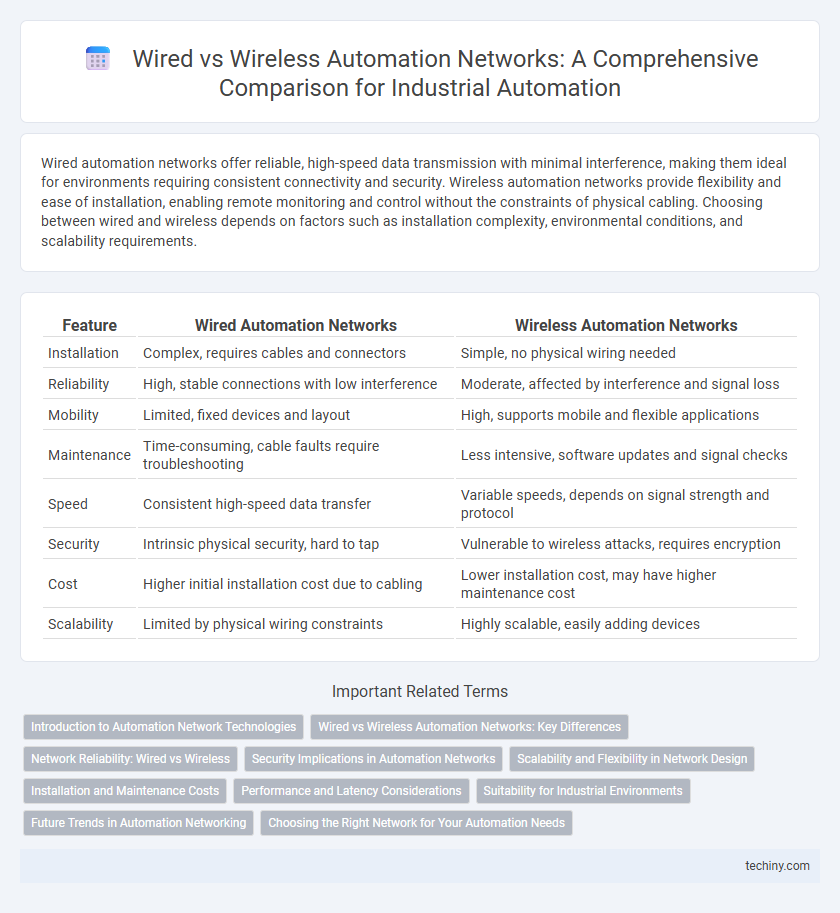Wired automation networks offer reliable, high-speed data transmission with minimal interference, making them ideal for environments requiring consistent connectivity and security. Wireless automation networks provide flexibility and ease of installation, enabling remote monitoring and control without the constraints of physical cabling. Choosing between wired and wireless depends on factors such as installation complexity, environmental conditions, and scalability requirements.
Table of Comparison
| Feature | Wired Automation Networks | Wireless Automation Networks |
|---|---|---|
| Installation | Complex, requires cables and connectors | Simple, no physical wiring needed |
| Reliability | High, stable connections with low interference | Moderate, affected by interference and signal loss |
| Mobility | Limited, fixed devices and layout | High, supports mobile and flexible applications |
| Maintenance | Time-consuming, cable faults require troubleshooting | Less intensive, software updates and signal checks |
| Speed | Consistent high-speed data transfer | Variable speeds, depends on signal strength and protocol |
| Security | Intrinsic physical security, hard to tap | Vulnerable to wireless attacks, requires encryption |
| Cost | Higher initial installation cost due to cabling | Lower installation cost, may have higher maintenance cost |
| Scalability | Limited by physical wiring constraints | Highly scalable, easily adding devices |
Introduction to Automation Network Technologies
Wired automation networks utilize physical cables such as Ethernet or fieldbus systems to ensure high reliability, low latency, and stable data transmission in industrial environments. Wireless automation networks rely on technologies like Wi-Fi, Bluetooth, or Zigbee, offering flexible deployment and reduced installation costs but facing challenges with interference and security. Selecting the appropriate network depends on factors including data rate requirements, environmental conditions, and scalability needs within automated systems.
Wired vs Wireless Automation Networks: Key Differences
Wired automation networks offer high reliability, low latency, and enhanced security due to their physical cabling infrastructure, making them ideal for mission-critical industrial environments. Wireless automation networks provide greater flexibility and scalability, enabling remote access and easier installation but often face challenges such as interference, limited bandwidth, and higher latency. Choosing between wired and wireless depends on factors like environmental conditions, required data transfer speed, and network stability.
Network Reliability: Wired vs Wireless
Wired automation networks offer superior reliability due to consistent signal transmission and minimal interference, ensuring stable and uninterrupted data flow critical for industrial processes. Wireless automation networks, though flexible and easier to deploy, face challenges such as signal degradation, electromagnetic interference, and physical obstructions that can compromise network stability. Network reliability in wired systems supports high-precision applications requiring low latency, whereas wireless networks require advanced error correction and redundancy mechanisms to approach similar reliability levels.
Security Implications in Automation Networks
Wired automation networks offer enhanced security due to physical connections that limit unauthorized access and susceptibility to wireless attacks. Wireless automation networks face increased risks from eavesdropping, signal interference, and unauthorized access, necessitating robust encryption and authentication protocols. Implementing stringent security measures in both network types is critical to safeguarding industrial control systems and ensuring operational integrity.
Scalability and Flexibility in Network Design
Wired automation networks offer high scalability through structured cabling systems that support extensive device integration and reliable communication, making them ideal for large industrial installations. Wireless automation networks provide superior flexibility in network design by enabling easy reconfiguration and rapid deployment without physical cabling constraints, which is essential for dynamic environments and mobile assets. Combining wired and wireless networks can optimize scalability and flexibility, leveraging the strengths of both for robust and adaptable automation systems.
Installation and Maintenance Costs
Wired automation networks typically involve higher initial installation costs due to extensive cabling and labor requirements, but offer lower ongoing maintenance expenses because of their stable and secure connections. Wireless automation networks reduce installation complexity and costs by eliminating physical cables, yet may incur increased maintenance costs related to signal interference, battery replacements, and network security management. Choosing between wired and wireless solutions depends on specific operational requirements, budget constraints, and the environment where the automation system is deployed.
Performance and Latency Considerations
Wired automation networks typically offer superior performance and lower latency due to dedicated physical connections, providing consistent data transfer rates essential for real-time control systems. Wireless automation networks may experience variable latency and interference, which can impact time-sensitive applications, although advances in wireless standards are closing the performance gap. Selecting the appropriate network depends on the criticality of latency requirements and environmental constraints within industrial automation settings.
Suitability for Industrial Environments
Wired automation networks offer unparalleled reliability and low latency, making them ideal for industrial environments with high electromagnetic interference and stringent safety requirements. Wireless automation networks excel in flexibility and ease of deployment, suitable for dynamic or hard-to-reach locations but may face challenges with signal stability and security concerns. Selecting the appropriate network depends on factors like operational criticality, environmental conditions, and infrastructure scalability needs.
Future Trends in Automation Networking
Wired automation networks continue to offer high reliability and low latency essential for critical industrial processes, while wireless automation networks provide flexibility and scalability driven by advances in 5G, Wi-Fi 6E, and emerging 6G technologies. Future trends indicate an increased adoption of hybrid networking architectures combining wired backbone systems with localized wireless nodes to optimize data throughput and reduce deployment costs in smart factories. Edge computing integration and enhanced cybersecurity protocols will be pivotal in supporting the seamless operation of these converged automation networks.
Choosing the Right Network for Your Automation Needs
Wired automation networks offer high reliability, low latency, and enhanced security, making them ideal for mission-critical industrial applications requiring consistent data transmission. Wireless automation networks provide flexibility, ease of installation, and scalability, suitable for dynamic environments where mobility and rapid deployment are essential. Selecting the right network requires evaluating factors like environmental conditions, data throughput requirements, network stability, and budget constraints.
Wired Automation Networks vs Wireless Automation Networks Infographic

 techiny.com
techiny.com